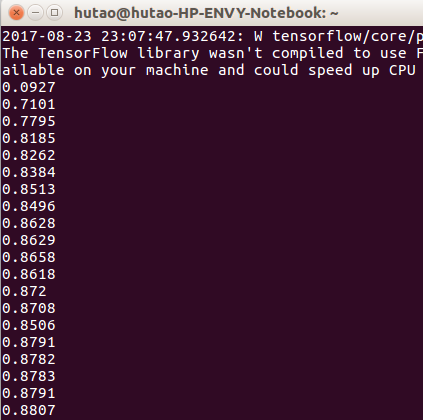为什么批标准化:
(1)你可以选择比较大的初始学习率,让你的训练速度飙涨 (2)你再也不用去理会过拟合中drop out、L2正则项参数的选择问题 (3)再也不需要使用使用局部响应归一化层了,因为BN本身就是一个归一化网络层 (4)可以把训练数据彻底打乱Batch Normalization网络层的前向传导过程公式:
代码实现mnist:
import tensorflow as tf
from tensorflow.examples.tutorials.mnist import input_data
#number 1 to 10 data自动下载数据集
mnist = input_data.read_data_sets('MNIST_data', one_hot=True)
def add_layer(inputs, in_size, out_size, activation_function=None, norm=False):
# weights and biases (bad initialization for this case)
Weights = tf.Variable(tf.random_normal([in_size, out_size], mean=0., stddev=1.))
biases = tf.Variable(tf.zeros([1, out_size]) + 0.1)
# fully connected product
Wx_plus_b = tf.matmul(inputs, Weights) + biases
# normalize fully connected product
if norm:
# Batch Normalize
# axes 这批数据的哪几个维度上求均值与方差
# the dimension you wanna normalize, axes[0] for batch只要0维度上就OK
# for image 三个维度上求均值方差, you wanna do [0, 1, 2] for [batch, height, width] but not channel
fc_mean, fc_var = tf.nn.moments(Wx_plus_b, axes=[0,1,2], )
scale = tf.Variable(tf.ones([out_size]))
shift = tf.Variable(tf.zeros([out_size]))
epsilon = 0.001
# 应用均值和变量的移动平均值,BN在神经网络进行training和testing的时候,所用的mean、variance是不一样的
ema = tf.train.ExponentialMovingAverage(decay=0.5)
def mean_var_with_update():
ema_apply_op = ema.apply([fc_mean, fc_var])
with tf.control_dependencies([ema_apply_op]):
return tf.identity(fc_mean), tf.identity(fc_var)
mean, var = mean_var_with_update()
Wx_plus_b = tf.nn.batch_normalization(Wx_plus_b, mean, var, shift, scale, epsilon)
# similar with this two steps:
# Wx_plus_b = (Wx_plus_b - fc_mean) / tf.sqrt(fc_var + 0.001)
#scale为扩大的参数,shift为平移的参数
# Wx_plus_b = Wx_plus_b * scale + shift
# activation
if activation_function is None:
outputs = Wx_plus_b
else:
outputs = activation_function(Wx_plus_b)
return outputs
def compute_accuracy(v_xs, v_ys):
global prediction
#用v_xs得出y的预测值:y是根据哪个数值概率更高得出来的
y_pre = sess.run(prediction, feed_dict={xs: v_xs})
#比较预测值与真实值是否相等
correct_prediction = tf.equal(tf.argmax(y_pre,1), tf.argmax(v_ys,1))
#计算多少个是对的多少个是错的
accuracy = tf.reduce_mean(tf.cast(correct_prediction, tf.float32))
#run得到一个百分比
result = sess.run(accuracy, feed_dict={xs: v_xs, ys: v_ys})
return result
# define placeholder for inputs to network
xs = tf.placeholder(tf.float32, [None, 784]) # 28x28
ys = tf.placeholder(tf.float32, [None, 10]) #10种输出
# add output layer,激活函数softmax,用于分类的激活函数
prediction = add_layer(xs, 784, 10, activation_function=tf.nn.softmax)
# the error between prediction and real data,分类的loss函数:交叉熵代价函数
cross_entropy = tf.reduce_mean(-tf.reduce_sum(ys * tf.log(prediction),reduction_indices=[1])) # loss
#梯度下降优化法,最小化loss函数,学习率0.5
train_step = tf.train.GradientDescentOptimizer(0.9).minimize(cross_entropy)
sess = tf.Session()
# important step
init = tf.global_variables_initializer()
sess.run(init)
for i in range(1000):
#获取100个数据,100个100个学习
batch_xs, batch_ys = mnist.train.next_batch(100)
sess.run(train_step, feed_dict={xs: batch_xs, ys: batch_ys})
if i % 50 == 0:
#输出每一步的准确度
print(compute_accuracy(mnist.test.images, mnist.test.labels))结果:
























 3054
3054

 被折叠的 条评论
为什么被折叠?
被折叠的 条评论
为什么被折叠?








